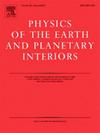The impact of LLVPs on regional secular variation of the magnetic field
IF 1.9
3区 地球科学
Q2 GEOCHEMISTRY & GEOPHYSICS
引用次数: 0
Abstract
The Large Low Velocity Provinces (LLVPs) are two poorly understood features at the base of the mantle that are typically studied with seismology and explained using geodynamical models of Earth evolution. However, there are few insights from the geomagnetic perspective about how these mantle features affect main field generation, or if they perturb the motion of the Earth's outer core, without assuming their physical properties. In this study, we test three regional methodologies, namely pointwise estimate on a spatial grid, spherical harmonic analysis, and spherical Slepian functions, to separate secular variation (SV, the first time derivative of the magnetic field) in the areas beneath the LLVPs and their complement.
While all three methodologies have drawbacks and differences, our findings of the proportion of SV energy inside and outside LLVPs are robust. When inverting data from geomagnetic virtual observatories over the satellite era, the proportion of SV energy under the LLVPs is found to be between 12 % and 18 % of the total SV energy at the Earth's surface which is less than the percentage surface area of the LLVPs. However, the percentage of SV energy is larger than the corresponding surface area when separating the COV-OBS.x2 SV model, between 29 % and 37 % inside LLVPs at the Earth's surface and 33 % and 49 % at the core-mantle boundary (CMB). For both datasets the African LLVP contributes approximately 2.5 times the amount of SV energy as the Pacific LLVP at the Earth's surface but only around 1.3 times more energy at the CMB.
LLVPs show time-varying SV under their footprint on decadal timescales which, therefore, indicates that core flow varies significantly underneath them rather than being regions of stilted flow. As well as presenting a novel inversion methodology that inverts for a spherical Slepian model, rather than using spherical Slepian functions to separate an existing spherical harmonic model, we also show for the first time that the timings of geomagnetic jerks correspond with inflection points in the magnitude of spectral or spatial energy in regional SV models. We conclude that there is no evidence that SV is systematically suppressed beneath LLVPs.

llvp对区域磁场长期变化的影响
大低速道(llvp)是位于地幔底部的两个鲜为人知的特征,通常用地震学研究,并使用地球演化的地球动力学模型来解释。然而,从地磁的角度来看,这些地幔特征如何影响主磁场的产生,或者它们是否扰乱了地球外核的运动,如果没有假设它们的物理性质,就很少有见解。在这项研究中,我们测试了三种区域方法,即空间网格点估计、球谐分析和球Slepian函数,以分离llvp下方区域的长期变化(SV,磁场的第一次导数)及其补充。虽然这三种方法都有缺点和差异,但我们关于llvp内部和外部SV能量比例的发现是稳健的。对卫星时代的地磁虚拟观测站数据进行反演,发现在llvp下的SV能量占地球表面总SV能量的比例在12%到18%之间,小于llvp表面积的百分比。但在分离COV-OBS时,SV能量的百分比大于相应的表面积。x2 SV模型中,地球表面llvp内部占29% - 37%,地核-地幔边界(CMB)占33% - 49%。对于这两个数据集,非洲LLVP在地球表面贡献的SV能量大约是太平洋LLVP的2.5倍,但在CMB的能量只有1.3倍左右。在年代际时间尺度上,llvp在其足迹下显示出时变的SV,因此,这表明其下方的岩心流动变化显著,而不是作为高跷流动的区域。除了提出了一种新的反演方法,即反演球形Slepian模型,而不是使用球形Slepian函数来分离现有的球形调和模型,我们还首次证明了地磁跳变的时间与区域SV模型中频谱或空间能量大小的拐点相对应。我们的结论是,没有证据表明SV在llvp下被系统地抑制。
本文章由计算机程序翻译,如有差异,请以英文原文为准。
求助全文
约1分钟内获得全文
求助全文
来源期刊

Physics of the Earth and Planetary Interiors
地学天文-地球化学与地球物理
CiteScore
5.00
自引率
4.30%
发文量
78
审稿时长
18.5 weeks
期刊介绍:
Launched in 1968 to fill the need for an international journal in the field of planetary physics, geodesy and geophysics, Physics of the Earth and Planetary Interiors has now grown to become important reading matter for all geophysicists. It is the only journal to be entirely devoted to the physical and chemical processes of planetary interiors.
Original research papers, review articles, short communications and book reviews are all published on a regular basis; and from time to time special issues of the journal are devoted to the publication of the proceedings of symposia and congresses which the editors feel will be of particular interest to the reader.
 求助内容:
求助内容: 应助结果提醒方式:
应助结果提醒方式:


